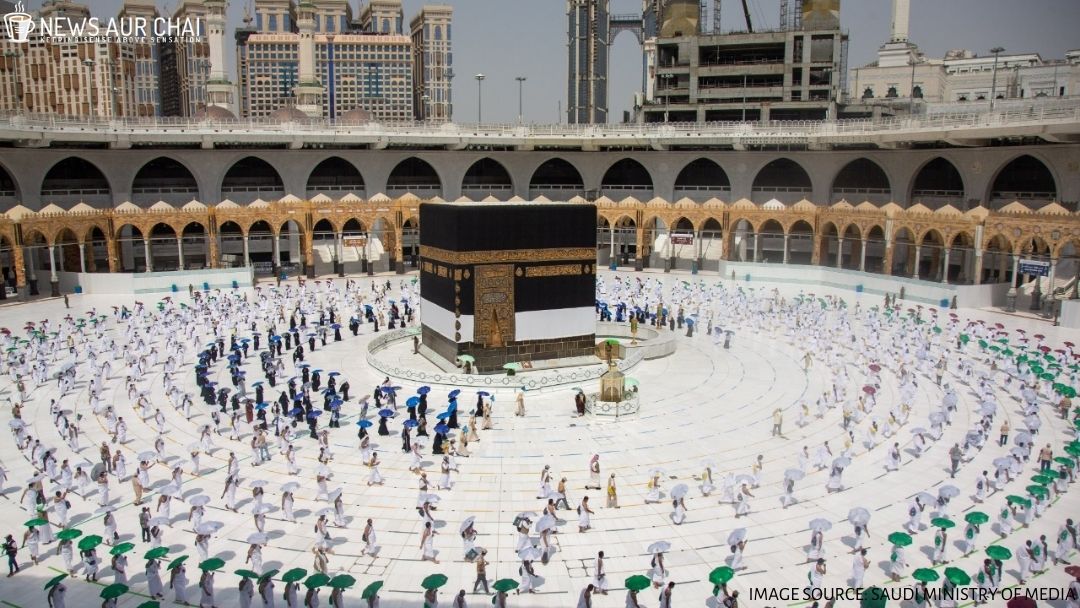
One of the most prominent religious gatherings in the world, the Hajj Pilgrimage, made history as it was carried out on Friday with only 1000 pilgrims taking part this year when compared to the 2.5 million visitors in 2019. The Saudi Arabian Government, which had banned visitors from all other countries, had laid down restrictions and spent billions to carry out the gathering in as safe and secure manner as possible, due to the ongoing Coronavirus pandemic.
Hajj is one of the five holy pillars in Islam, and it is the duty of every able-bodied Muslim who can afford it, to carry out the once-in-a-lifetime ritual.
Tawaf being performed around the Ka’bah with social distancing in place.#Hajj2020 pic.twitter.com/rR4CKRetfi
— Muslim Landmarks Explored (@MuslimLandmarks) July 29, 2020
The pictures and videos showing Hajj being performed while practising social distancing were widely circulated in social media and depicted the pilgrims circling the Kaaba, the holy structure in Islam covered in black cloth and Arabic script written on silk cloth. It is in the direction of the Kaaba that Muslims face while praying, and unlike the previous years, they were not allowed to touch the holy edifice.
They were also shown clutching umbrellas as protection against Saudi’s summer heat in the photographs.
https://twitter.com/Iam_Mian1/status/1288412484110557186
Online Protocol to Select Pilgrims
Owing to the current pandemic situation, the Saudi Government has announced that only 10,000 pilgrims were allowed to visit this year from within the kingdom and that all visitors from other countries were banned. Pilgrims aged between 20 and 50 who were not showing symptoms of the virus were allowed to apply for the ritual online. The visitors who had not performed Hajj before were given preference while selecting them.
The online protocol is followed a Coronavirus test, post which the pilgrims get wristbands connected to their phones to monitor their movements.
According to a news report by Times Now, the pilgrims are required to stay back for a week in quarantine after the conclusion of the ritual on Sunday.
Labbaik Allahumma Labbaik💜
Stills from the last moments of this year's Hajj rites. In the midst of Covid crisis, a small number of Muslims were able to complete hajj following health precautions…. #Hajj2020 #COVID19 pic.twitter.com/w8o4OpZKzz
— ️Ladeeda Farzana (@ladeedafarzana) July 29, 2020
Social Distancing Norms Enforced Scrupulously
Apart from its religious significance, Hajj is also known to be a significant source of tourism revenue for the kingdom and accounts for 2.7 per cent of Saudi’s Gross Domestic Product (GDP) according to a Hindustan Times report. Due to the increasing number of COVID-19 cases in Saudi Arabia, however, the government has decided to ban any travel to and from the kingdom and restricted the ritual to its citizens.
Over 30 per cent of the people present at the gathering will be security and healthcare professionals appointed by the government. According to an Al Jazeera report, over 3000 workers are working every day to sanitize Mecca’s Grand Mosque with 11,000 gallons of disinfectant and almost 300 gallons of air fresheners. The floors of the mosque are periodically scrubbed, up to three times a day.
The masked pilgrims are allowed to circle the Kaaba in groups of 50, with a safe distance 1.5 meters between them, and the stones used to throw at pillars that symbolize the devils are sterilized as well. The holy water was also handed out in single-use bottles.





